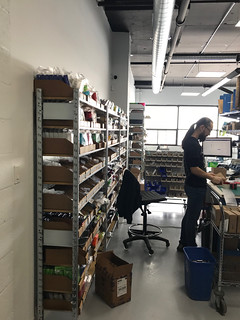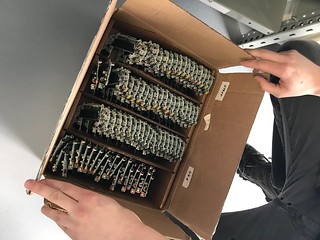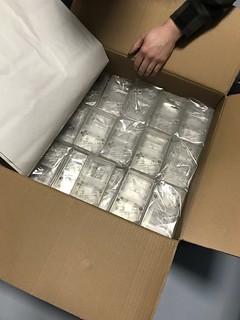The Game Boy’s Second Life: A Conversation with Retro Modding’s Olivier
Hardware modification (or “modding”) is the physical alteration of video game platforms for aesthetic or functional purposes. Sometimes, the goal is to make the hardware perform functions the manufacturer did not intend, such as amplifying audio or introducing a backlight. Other times, the purpose might be to customize the look of the device by painting or even replacing its case with an aftermarket shell (“case modding”). At the Residual Media Depot, we believe mods have a lot to say about the way that people continue to use their video game hardware in ways that exceed their manufacturers’ intentions. So when we had the chance to visit Retro Modding here in Montreal, we jumped at the chance.
Retro Modding’s Unintended Beginning
For Olivier, the founder and owner of the company, modding started out as a hobby, tinkering with a platform to which he had a sentimental attachment. “I had good memories with my first Game Boy when I was a kid,” he reflects. “Looking on YouTube, I saw people modding and adding backlights and I wanted to make one for myself.” He still has this handheld in the office, evidence of the nostalgic underpinnings of the whole enterprise.
The experience of
this early mod stayed in the back of Olivier’s mind for a few years, returning
in full force when he began to build himself a game collection. “I ended up
getting lots of games and multiple game consoles and the more games I bought,
the more defective game consoles I ended up with. So I started buying repair
parts and I got them in bulk to save money and then lots of bulk parts ended up
taking space at home and then I thought maybe I can start selling those extra
repair parts.” Things snowballed from there (something we at the Depot can
understand completely). Three years later, Olivier and Retro Modding have
modded over 1,400 handhelds, over half of which are GBAs.
So who are the
customers? Olivier tells us that around 80% of Retro Modding’s customers are
men aged 25-35. “Those people grew up with Game Boys.” Although Nintendo has
recently sought to expand their target audience, throughout the 1990s and early
2000s, young boys were their target demographic. Now grown up and with
disposable income, these players are drawn to modded handhelds as a way of
re-engaging with childhood experiences. Modded platforms connect this nostalgic
fondness for the Game Boy or Game Boy Advance with all the affordances we
expect from a contemporary gaming device.
“We Don’t Do Nintendo, We Do Mods”
There are interesting
(if often blurry) distinctions between preserving and modding video game
hardware along the lines of aesthetics, performance, and economics.
Though nostalgia
may fuel the desires of many of their customers, Retro Modding isn’t trying to reproduce
some fantasy about the ineffable quality of playing on original hardware. After
all, childhood memories aren’t only fundamentally irretrievable but also often disappointing
(no, seriously, turn on a GBA and try playing your favourite game without a
backlight).
Like a debadged
custom car, Retro Modding’s brand is effectively a lack of branding, an erasing of the corporate name to remind
consumers that this isn’t just a Nintendo product anymore (while also evading
issues of trademark infringement). With and without Nintendo, the Game Boy
continues to advance. As Olivier puts it, “we don’t do Nintendo, we do mods.”
One of the ways
the tension emerges is through branding, especially because of the cultural
cachet of the Nintendo name. “There’s a market for the logo,” Olivier says.
“And that’s where we want to stand out. There’s already the whole aftermarket
that’s releasing stuff with Nintendo branding. And not only does the Nintendo logo
not look good on those aftermarket parts, I don’t think it represents the same
quality as genuine Nintendo products. So you get cheap parts made in cheap
factories on large scales. So on our end, we prefer to release parts that are
unbranded, but that reach [a similar quality to Nintendo’s].”
The Business of Hardware Modding
Modding consists of a sometimes bewildering variety of practices, but Retro Modding’s work falls into several very definite categories. For the GBA, their most popular category of built-to-order handhelds by a wide margin, Retro Modding offers a variety of features. These include a voltage regulator with a sleep feature (a relatively new component developed by BennVenn); a digital brightness controller that uses pulse width modulation (PWM) to dim the backlight; their lithium-ion battery pack; a multi-speed accelerator; and pro sound audio amps.
“You’re limited
with what you can do for the GBA,” says Olivier, but for Retro Modding, that
limit comes from trying to ensure a high level of quality. “There’s lots of
people coming up with ideas but they won’t test them from a user point of
view.” Most of Retro Modding’s in-house components are designed to optimize
existing mods.
For example, they
observed that many people failed to properly integrate the voltage regulator
when performing the AGS-101 backlight mod (replacing the 2001 GBA’s screen with
the screen from the 2005 backlit GBA SP). Performing the mod requires soldering
a wire to the printed circuit board (PCB) itself. But what ends up happening is
that modders will put 11V into the 5V rail, which can damage the handheld over
time. By isolating the LCD’s backlight from the rest of the circuit and feeding
the voltage to directly to the LCD, they dramatically reduce the failure rate
of their mods.
Retro Modding also installs a large number of their in-house amplifiers. This is one of those features that exists just to exist rather than arising from functional necessity (in a Spinal Tap “it goes to eleven” kind of way). It only affects the audio output through the speakers, not the headphones – the area where GBA sound actually needs the most improvement. If you’re playing the GBA in the quiet comfort of your home, its maximum volume is more than loud enough to allow you to hear the game sound. If you’re playing the GBA in a noisy public environment, you probably shouldn’t be blasting tinny Super Mario Advance sound effects for your fellow citizens. And chiptune artists probably aren’t outputting through the GBA speaker. Thus, while the audio amplifier is clearly intended to optimize the handheld’s performance, it’s also heavily aestheticized.
Another of Retro Modding’s popular alterations is the glass lens that replaces the plastic one in the 2001 GBA. This replacement has become trendy in GBA modding circles, perhaps not incidentally because the swap removes the GBA logo from beneath the screen. This is Olivier’s least favorite part of actually modding a handheld. “I’d say that almost 30% of the modding is just that lens, get[ing] the dust out and any marks off the lens, any grease residue. It is a struggle. Ask anyone here – it’s hell, always.”
Sometimes, mods slip
from frustrating into dangerous, particularly when we’re talking about modding
the original Game Boy, which involves removing the reflective polarizer film
from the back of the screen. “That’s glass and you will apply pressure on it to
remove it. You can cut yourself. It did explode at some point. Things can go
bad. You can damage it and finding a suitable front PCB that’s working and
unscratched is hard and it’s getting harder and harder. So if you break one,
you’re removing one from the market.”
Celebrating its
thirtieth birthday this year, Game Boy numbers are dwindling as the ageing components
begin to break down. This means that companies like Retro Modding have an
increasingly difficult time sourcing parts. “Doing mods” isn’t just a just a
matter of technical mastery and tinkering with electronic innards. For Olivier,
it’s also about running a business, things we might take for granted if we
consider the modding industry as little more than DIY electronics.
As owner, one of
Olivier’s jobs is to trawl the internet in search of functional, moddable
platforms. Unlike many of his competitors, he’s not content to sell sub-optimal
products, a testament to his emphasis on performance. Oftentimes, he’ll set a
printed circuit board (PCB) aside because there’s too much noise, which becomes
magnified if the customer orders an amplifier. It’s a delicate balance between
profit and performance. Even if the customer never uses the amplifier at full
volume, Olivier doesn’t want to sell a noise-heavy handheld. Retro Modding errs
on the side of delivering a product that exceeds customers’ expectations and
justifies their premium price tags.
In addition to navigating these dilemmas, there are other concerns. There are questions of insurance and risk when storing and shipping potentially volatile batteries. There are issues of international shipping (there are social and political reasons it’s cheaper to ship video game hardware to the United States than Canada). There’s social engineering that goes into building close professional relationships with the manufacturers in China who produce many of the parts they use. Language barriers and time zones take up a huge amount of his time, but the result is a growing set of overseas allies that allow Olivier to expand his business.
The Second Life of Nintendo’s Handhelds
As Nintendo continues to manufacture new handhelds within the larger regime of planned obsolescence, they exhibit a curiously ambivalent attitude toward the ownership of their platforms.
On the one hand, the
company is notoriously hostile to the modding community and heavily invested in
prescribing how they expect players to use their platforms: play licensed
games, don’t open the platform, buy our next handheld.
On the other, they
don’t seem to mind that disuse means that the millions of these devices that
they sell end up in our already-overflowing landfills.
“It’s like they
lose responsibility as soon as they release it and it gets to the consumer’s
house,” Olivier says. “They shouldn’t be restrictive about how that stuff is
handled afterwards because it will end up in a landfill somewhere. We’re talking about millions of Game Boys,
all that plastic and all those PCBs with strange chemicals.”
Media scholar Lisa Parks notes that most discarded consumer electronics end up with electronics salvaging firms, who have developed profitable businesses grounded in the exploitation of migrant workers and prisoners.[1] These firms transport most North American e-waste to parts of Asia where environmental regulations are lax, or else dispose of parts in landfills near low-income neighborhoods where they’re concealed to the white upper and middle classes. More to the point, this reshuffling of electronics components has tangible effects on the water and soils as plastics and PCBs leach carcinogenic chemicals into environments deemed less important by the privileged elite of North America.
So concerns about sustainability are part of the larger Retro Modding agenda. “I think [Nintendo] should somehow promote the second life of their objects,” Olivier says. “Given the amount of money people spend on those consoles, you should be able to do whatever you want with it. You can’t prevent people from doing it anyways, so better make it in a way that [the consumer] won’t break it or damage it. Having an open-source architecture could bring more to the console.”
Hardware modding confronts users with the reality of consumer electronics. The boards and shells lining Olivier’s warehouse aren’t languishing in a landfill somewhere. They’re being used – perhaps not in the way Nintendo intended, but nevertheless in a way that highlights an appreciation for the work that went into mining, extracting, refining, and manipulating the metals and components that make up the platform. It’s this phenomenon of residual reuse and repurposing that leads Olivier to see an element of preservation in the work he does. “There will always be consoles dying, so you just need to catch them before they do.”
Retro Modding currently has six top-secret projects in the works that Olivier was generous enough to show us. While we can’t say much, we can say that they’re definitely exciting and worth keeping an eye out for. Check out their website or follow them on Facebook to stay up to date.
[1] Parks, “Falling Apart: Electronics Salvaging and the Global Media Economy,” in Residual Media, ed. Charles R. Acland (Minneapolis, MN: University of Minnesota Press, 2007).



